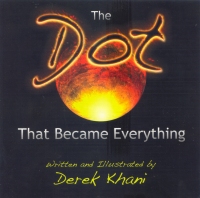| ________________
CM . . .
. Volume XXI Number 1. . . .September 5, 2014 
 |
The Dot That Became Everything.
Derek Khani.
Thunder Bay, ON: Split Tree Publishing, 2014.
36 pp., pbk., $11.00.
ISBN 978-0-9921668-5-4.
Kindergarten and up / Ages 5 and up.
Review by Valerie Nielsen.
*1/2 /4
|
| |
|

excerpt:
Once upon a TIME
there was no THING
Until there was a LIGHT
Shining upon a DOT
Aware of itself
The Dot began to
S T R E T C H
...into a solid cylindrical shape, which then stands upright to become a 1, next arches into a 2, follows by curving into a 3, and, in the succeeding 11 double-spread pages, forges itself into a 4, transforms into a 5, rolls itself into a 6, twists into an 8, nudges into a 9, zooms into a zero where, penultimately, it morphs into forms which (finally!) "...burst into EVERYTHING". For the last climactic page, author/illustrator Khani switches from black and white to soft colours and shapes evoking a metamorphosis which may (or may not) depict the beginning of our universe.
 Notes on the final page of The Dot That Became Everything inform the reader that Derek Khani, originally from the Seychelles, is an established multidisciplinary artist and educator who "believes in nurturing the spirit, of children in particular, through creative artistic exploration and self-inquiry. He is an advocate of personal and academic development through visual literacy, music and the practice of mindfulness." Notes on the final page of The Dot That Became Everything inform the reader that Derek Khani, originally from the Seychelles, is an established multidisciplinary artist and educator who "believes in nurturing the spirit, of children in particular, through creative artistic exploration and self-inquiry. He is an advocate of personal and academic development through visual literacy, music and the practice of mindfulness."
The above comments throw some light upon the outlook of the author, as well as (perhaps) what he may be saying between the lines in his artistic effort to bring numbers to life. Unfortunately, other than the use of imaginative active verbs as the main characters of the story transform themselves into their well recognized shapes, the point of this 16 paged picture book is far from clear. Is it an unorthodox version of a creation myth intended to lead the reader toward “artistic exploration and self-inquiry”? This delightful gem of a book is sure to captivate readers of all ages," reads the blurb on the back. However, my eight-year-old granddaughter's comment after reading it was: "I don't get this story. It doesn't make any sense to me." After several perusals accomplished by a reader a good deal older and a fair bit more literate than the third grader quoted above, another central problem of The Dot That Became Everything remains. Just what IS the age (or age-range) of the readers that Derek Khani's picture book is “sure to captivate”?
Not Recommended.
A retired teacher-librarian, Valerie Nielsen lives in Winnipeg, MB.

To comment
on this title or this review, send mail to cm@umanitoba.ca.
Copyright © the Manitoba Library Association. Reproduction for personal
use is permitted only if this copyright notice is maintained. Any
other reproduction is prohibited without permission.
Next Review |
Table of Contents for This Issue
- September 5, 2014.
CM Home | Back Issues
| Search
| CM Archive
| Profiles Archive
|

 Notes on the final page of The Dot That Became Everything inform the reader that Derek Khani, originally from the Seychelles, is an established multidisciplinary artist and educator who "believes in nurturing the spirit, of children in particular, through creative artistic exploration and self-inquiry. He is an advocate of personal and academic development through visual literacy, music and the practice of mindfulness."
Notes on the final page of The Dot That Became Everything inform the reader that Derek Khani, originally from the Seychelles, is an established multidisciplinary artist and educator who "believes in nurturing the spirit, of children in particular, through creative artistic exploration and self-inquiry. He is an advocate of personal and academic development through visual literacy, music and the practice of mindfulness."